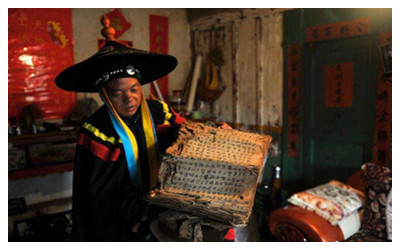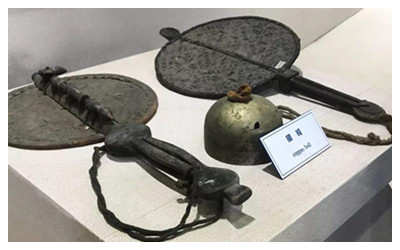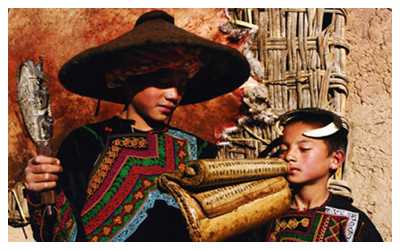Skype: neodalle-travel
Tel: +86 135 7447 2266
E-mail: sales@visitaroundchina.com

 The Bimo Culture is also known as Yi Culture. According to a census taken in 1990, the number of the Yi living in Yunnan (4.05 million) is 60 percent of the total Yi population throughout China; this fact not only renders Yunnan a province that has the largest distribution of Yi people but also makes the Yi the most populous among all the minority groups in this province. Bimo Culture, therefore, plays a significant role in the ethnic cultures of Yunnan.
The Bimo Culture is also known as Yi Culture. According to a census taken in 1990, the number of the Yi living in Yunnan (4.05 million) is 60 percent of the total Yi population throughout China; this fact not only renders Yunnan a province that has the largest distribution of Yi people but also makes the Yi the most populous among all the minority groups in this province. Bimo Culture, therefore, plays a significant role in the ethnic cultures of Yunnan.Bimo, the Chinese transliteration of the Yi equivalent meaning "ceremonial master", is a host of sacrificial ceremonies in the Yi primitive religion. But due to differences among the local Yi dialects, this term has different versions when put into Chinese, such as Baima, Beimao, Beima, and Bimu. Bimos, or whichever you like, came into existence at the end of the primitive society when the Yi primitive religion emerged; they knew the Yi language well, acquainted themselves with the Yi history and ceremonial customs, held sacrificial ceremonies, practiced divination, disseminated the Yi language, and even provided medical service for the common Yi people. In ancient times, Bimos were "divine personnel inseparable from the Yi chieftains even for a single moment", but they were degraded to the common during the Ming and Qing dynasties when hereditary chieftains were replaced by government-appointed officials.
 The Yi language, originating from ancient times, was known in historical books as the "Cuan language", the "Wei language", the "Luo language", "the ethnic language" or the "Luoluo language"; it is a monosyllabic language the characters of which, according to statistics, vary from 6,000 to 10,000 in different Yi inhabited areas. Although academic circles still do not agree on when and who created the Yi language, they generally believe that more characters were in use in the Ming and Qing dynasties than in the Tang according to surviving documents. One amazing fact about the Yi language is that it can be adopted to decipher some mysterious symbols on the pottery unearthed at the Banpo archaeological site near Xi'an which are recognized as the beginning of Chinese characters some 6,000 years old; the ancient Yi language also shares more than 100 characters with oracle bone inscriptions, the earliest known Chinese writing; thus it can be surely concluded that the Yi language bears the same historical origins with the Chinese language. There is a common saying that Bimos had much to do with the creation of the ancient Yi language, or to put it another way around, they have been in control of the language from the very outset and used it as a tool for religious activities.
The Yi language, originating from ancient times, was known in historical books as the "Cuan language", the "Wei language", the "Luo language", "the ethnic language" or the "Luoluo language"; it is a monosyllabic language the characters of which, according to statistics, vary from 6,000 to 10,000 in different Yi inhabited areas. Although academic circles still do not agree on when and who created the Yi language, they generally believe that more characters were in use in the Ming and Qing dynasties than in the Tang according to surviving documents. One amazing fact about the Yi language is that it can be adopted to decipher some mysterious symbols on the pottery unearthed at the Banpo archaeological site near Xi'an which are recognized as the beginning of Chinese characters some 6,000 years old; the ancient Yi language also shares more than 100 characters with oracle bone inscriptions, the earliest known Chinese writing; thus it can be surely concluded that the Yi language bears the same historical origins with the Chinese language. There is a common saying that Bimos had much to do with the creation of the ancient Yi language, or to put it another way around, they have been in control of the language from the very outset and used it as a tool for religious activities.
Bimos had, from the beginning to modem times, remained "ancient sages" who also served as historians, wizards and doctors. We can find in their roles they are somewhat superstitious in a sense, but the major part is ethnic knowledge and sciences instead of superstition. So there is every reason to claim that Bimos were folk intellectuals who preserved, inherited and disseminated the traditional Yi culture.
 The term Bimo Culture can be understood in two levels. In a broad sense, it includes the language, culture, literature, philosophy, history, religion, folklore, ethics, astronomy, almanacs, medicine, farming and husbandry of the Yi; in astronomical almanac, for instance, the Yi Ten-Month Solar Calendar is renowned for being season-accurate, easy-to-be-remembered and time-tested. It fully shows the world an aspect of the brilliant ancient Chinese culture; while in a narrow sense, the term is confined only to the primitive sorcery and religious scriptures with the Bimos being its highlights. When a Bimo practices his sacrificial witch craft, he usually makes use of such ritual implements as a black robe, a sacred hat with eagle claws indicating their religious authority, a divine fan, and a bronze bell. The ceremonies he hold include divining, averting, swearing, warding-off, oath taking and offering divine verdicts. Bimo scriptures, although varied and voluminous, fall roughly into 4 categories, namely divination, explication, prayer and sacrifice.
The term Bimo Culture can be understood in two levels. In a broad sense, it includes the language, culture, literature, philosophy, history, religion, folklore, ethics, astronomy, almanacs, medicine, farming and husbandry of the Yi; in astronomical almanac, for instance, the Yi Ten-Month Solar Calendar is renowned for being season-accurate, easy-to-be-remembered and time-tested. It fully shows the world an aspect of the brilliant ancient Chinese culture; while in a narrow sense, the term is confined only to the primitive sorcery and religious scriptures with the Bimos being its highlights. When a Bimo practices his sacrificial witch craft, he usually makes use of such ritual implements as a black robe, a sacred hat with eagle claws indicating their religious authority, a divine fan, and a bronze bell. The ceremonies he hold include divining, averting, swearing, warding-off, oath taking and offering divine verdicts. Bimo scriptures, although varied and voluminous, fall roughly into 4 categories, namely divination, explication, prayer and sacrifice.
The Yi classics are scattered among the people, and some are in other provinces or even other countries. Great attention has been paid to the work of collecting, sorting, and studying them since the foundation of P.R.C in 1949. In the early 1980s, the Central Nationalities University attempted to sort out the existent Yi classics in Beijing and obtained 659 books of which 514 were from the Chuxiong Yi Autonomous Prefecture of Yunnan; in 1982, the prefectural government held a forum to confirm Bimo as "intellectuals of the ancient Yi culture", and soon the Chuxiong Institute for the Yi Culture was established and some Bimos who had mastered the Yi language were recruited as researchers in this institute; by 1999, the institute had rendered 280 Yi classics (15 million characters) into Chinese and (approximately 0.7 million characters) published five of them.
 Ask Questions ?
Ask Questions ?